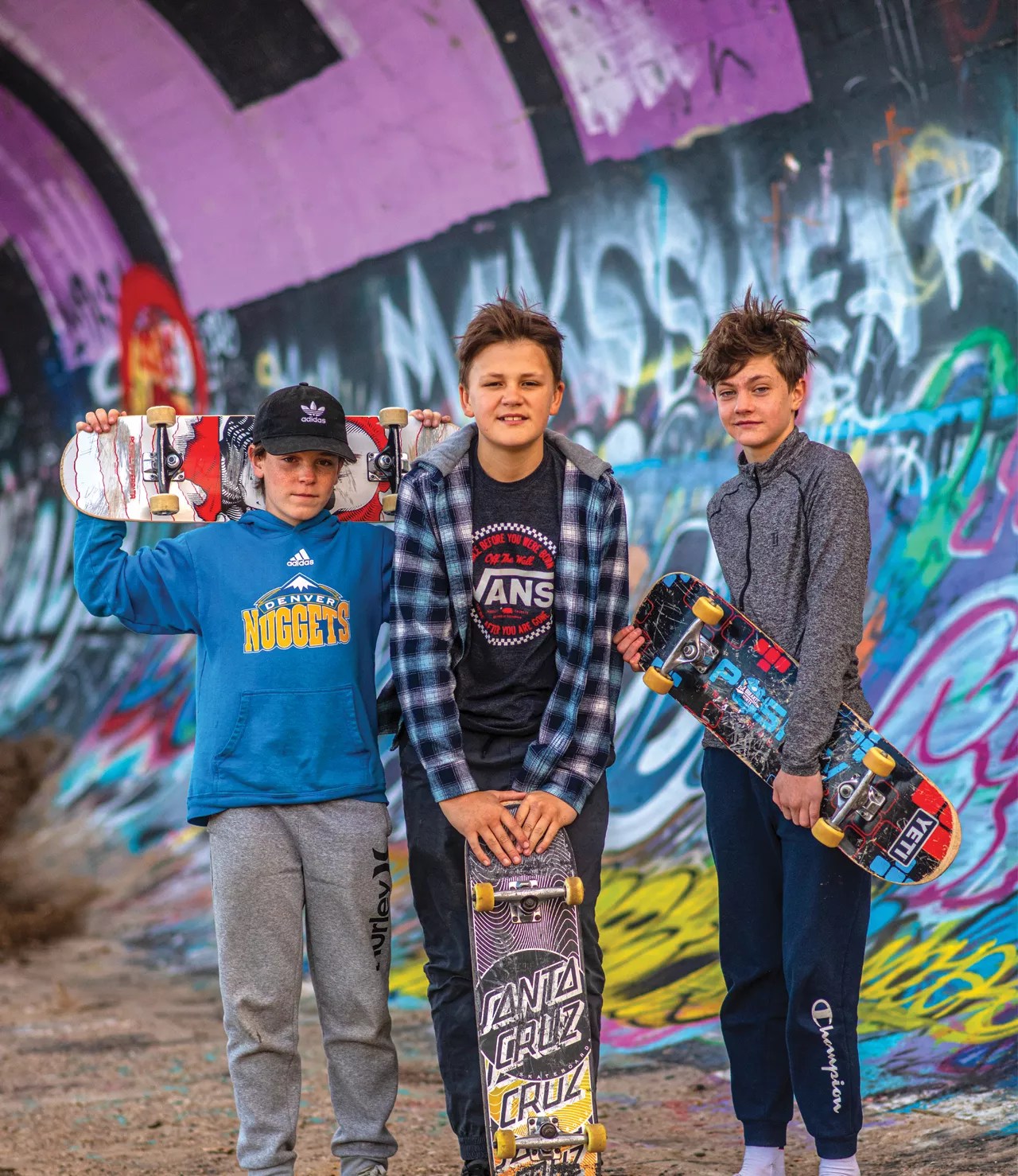
Evan Semón

Audio By Carbonatix
Last June, Porter Sturno, Brek Price and Ryder Perry – seventh-graders who live in the Wellshire neighborhood – met with Denver City Councilwoman Kendra Black at her office next to Southmoor Park to talk about their favorite activity: skateboarding.
The three had prepared their own PowerPoint presentation to show Black, who represents far southeast Denver, why this section of town needs a city-built skate park.
While there are city skate parks to the north – including the king of Denver’s skate park scene, the Denver Skatepark, on Little Raven Street – southeast Denver has none. The closest skate parks are in Greenwood Village and Littleton, and young skaters have to rely on getting rides to reach those.
“We don’t really have a convenient location for a skate park. We want something that’s easy to bike or skate to,” says Price.
The boys pitched Black on their idea of establishing a skate park in James A. Bible Park, which is located just east of Interstate 25 and north of East Hampden Avenue.
But they got some tough news from the councilwoman.
“I said, ‘Well, there might be a better place, because with climate change and the heat island we are experiencing in Denver, we don’t want to get rid of vegetation,'” Black recalls.
“She was mainly concerned about taking away grass from the environment and putting in concrete,” remembers Sturno.
The three thirteen-year-olds left Black’s office devastated. “I almost gave up,” admits Perry.
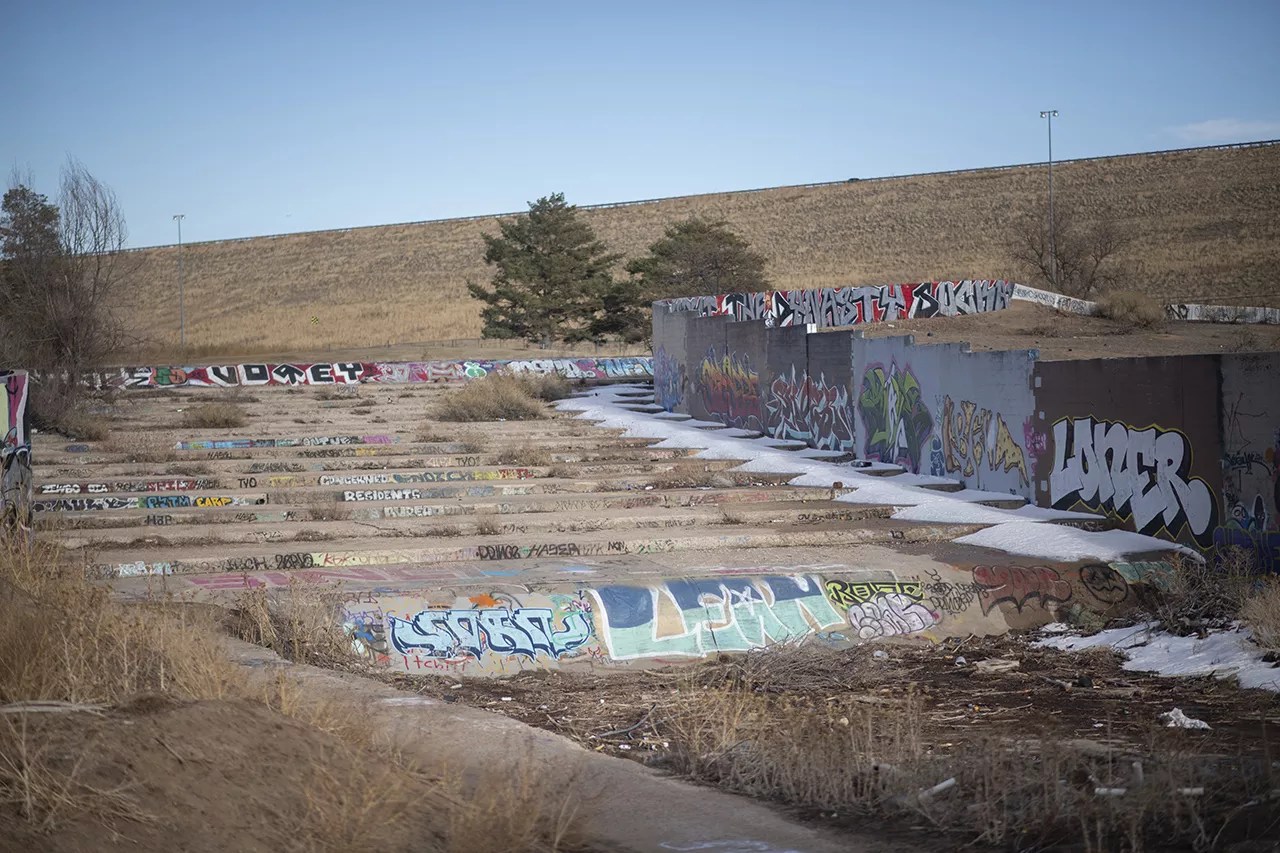
The abandoned Kenwood Dam spillway.
Evan Semón
Soon after that meeting, Black and some of her staffers visited the abandoned Kenwood Dam spillway, which is located near a section of Kennedy Golf Course as well as a soccer complex and a dog park. Plenty of golf balls land on the spillway from errant shots. There’s also a lot of graffiti on the concrete walls of the spillway, which Black and her team were scoping out as a possible location for city-commissioned murals.
“If you’re on I-225, you can see all the graffiti on that side of the spillway,” says Black, who’d never before been inside the fenced-off area. “Someone had cut the fence. It’s not supposed to be publicly accessible.”
As they considered the possibilities of using the spillway for murals, Black remembered the three young skateboarders who’d visited her office. “And then we were like, ‘Wow, this would be an amazing place for a skate park,'” she says.
But what kind of skate park?
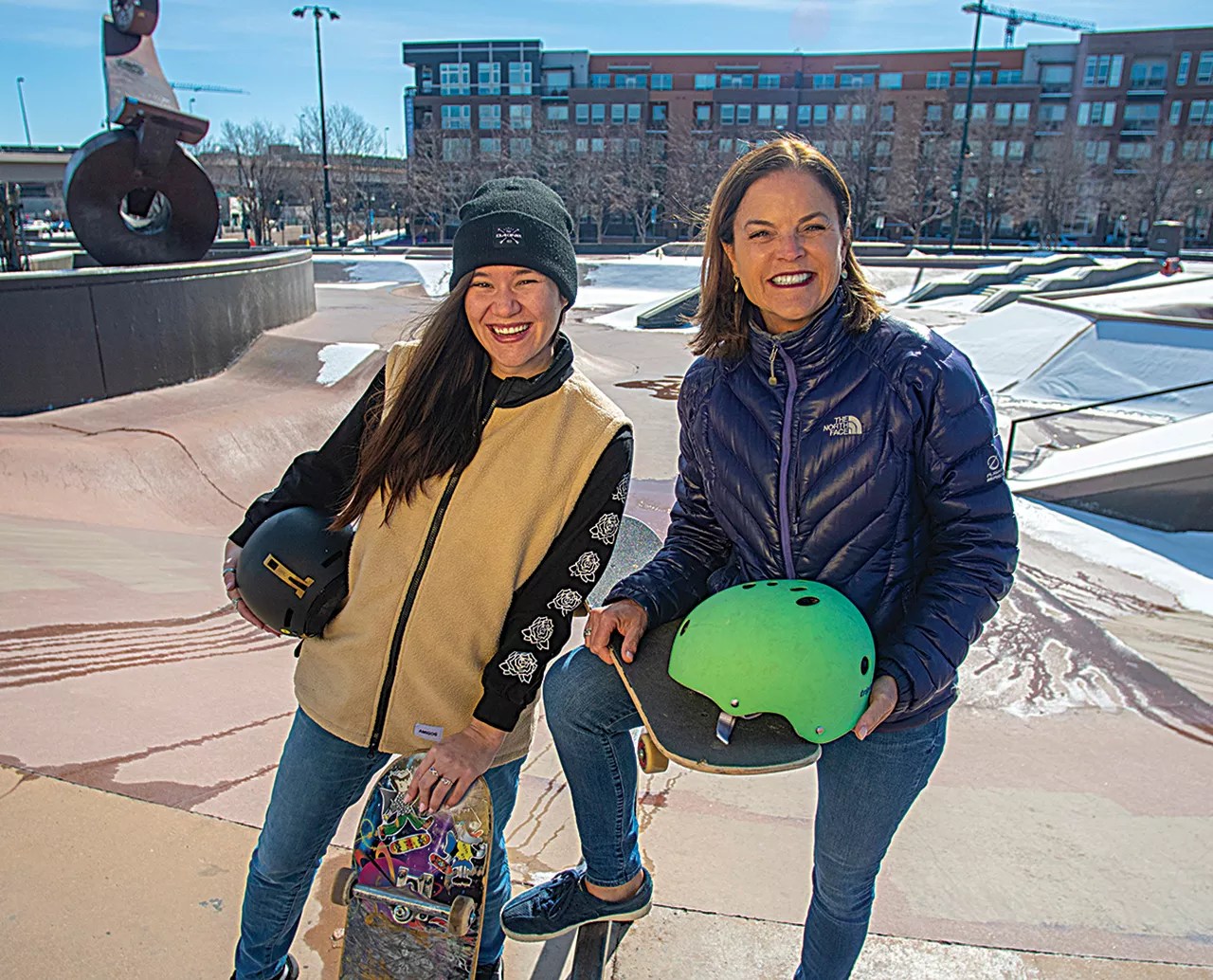
Kaily Blackburn (left) and Kendra Black at the iconic Denver Skatepark.
Evan Semón
Skateboarding is a quintessentially American invention. The sport was born in California in the middle of the twentieth century. Legend has it that surfers who wanted to surf on land when waves were low came up with the idea of putting wheels on boards.
By the 1960s, skateboarding had spread across the country as magazines devoted to the sport began popping up and technology advanced. In the 1970s, skateboard manufacturers really got things moving with polyurethane wheels.
“The advancement of technology in skateboarding in the ’70s with polyurethane wheels and independent trucks where you could navigate freely and move more freely than before, that opened up doors,” says 36-year-old Damian Dixon. Dixon grew up in Aurora and runs Speakeasy Skate, an online directory of Colorado skate parks.
For a time, private skate parks were popular across the country, particularly in metro Denver, where skateboarding caught on quickly, just as snowboarding would a few years later. Colorado is “middle America California,” explains 62-year-old Perry Linquist, an early skateboard fan.
One of the first parks to pop up in metro Denver was the Concrete Curl in Aurora, which opened in 1977. It cost $1.25 to enter, and Linquist, who grew up in Wheat Ridge, spent many days there. “I was hooked when I started doing that,” he recalls. But it didn’t last.
“The Concrete Curl closed on September 4, 1979. I remember it well. I skated there on the last day,” Linquist says.
“Skate parks just dwindled in popularity, here and in California,” he continues, “mainly because the insurance rates were high and you just couldn’t make enough money to pay it.”
But even as private skate parks fell out of favor, the sport was expanding globally, especially in Germany, and world-famous skaters like the legendary Tony Hawk were pushing the sport to higher levels. They were skateboarding out in the open, on anything they could find.
In the 1990s, competitions like the X Games brought even more attention to extreme sports. And in 1999, the release of the video game Tony Hawk’s Pro Skater helped reach audiences that weren’t yet into skating.
“Skateboarding was very frowned upon in the mainstream culture,” Dixon says, adding that the X Games helped turn the narrative around. “I am a product of the X Games and the Tony Hawk generation. The reason I skateboard is because of the X Games and the video game.”
In 2021, the sport debuted at the Summer Olympics in Tokyo.
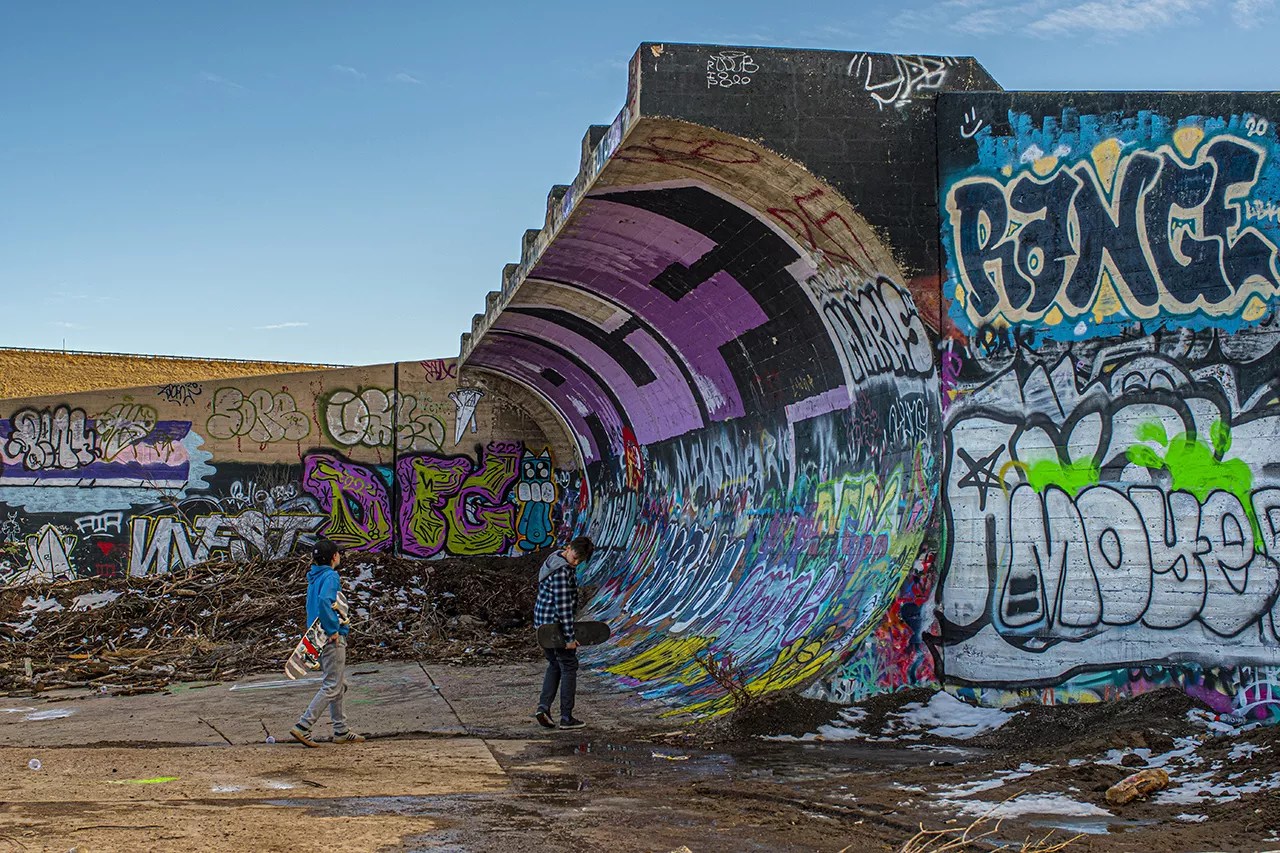
The abandoned Kenwood Dam spillway has the potential to become a skate park.
Evan Semón
While skateboarding was gaining more respectability as a sport, some skaters were going renegade. Linquist and other skaters boarded on the streets and made use of infrastructure, like gigantic pipes and abandoned pools, for fun skate sessions.
By the late 1990s, the City of Denver realized that it was time to build a large municipal skate park.
“What precipitated all the interest was that a bunch of kids, mostly skaters, were getting ticketed for skating on the 16th Street Mall,” says Dean Pearson, founder of Architerra Group, a local landscape architecture firm.
The city hired Pearson to work on a public skate park for Denver. Pearson brought together local skaters to workshop ideas for what type of park they might want. “We basically said no idea is stupid or too crazy,” he recalls. “The energy was pretty amazing.”
The City of Denver funded the project, which wound up in what was then a sleepy part of the city by the South Platte River and two parks, just past Union Station.
“The site that we thought was excellent was where it ended up being built: close to public transportation, close to the regional South Platte River Trail. It was really a prime piece of land,” Pearson says.
The first phase of construction wrapped up in 2001, with the second phase set to conclude in 2003.
But even before the facility was finished, the park became world-renowned when a group of famous professional skaters, including Hawk, Bob Burnquist and Bam Margera, visited it as part of Tony Hawk’s Gigantic Skatepark Tour, which ran on ESPN. Shaun White, then a budding skater who would later win many snowboard championships, was also on the tour.
Denverites, especially young ones, flocked to the skate park in the summer of 2002 to watch their idols perform tricks.
“I felt like Denver, even though it was sort of a struggle because it was slippery and we had a lot of people around and our vert demo was in a bowl, it was still good riding all around,” Hawk said after the event. Another one of the skaters on the tour called it a “great cement park.”
“Denver, when it first opened – there was no place in the country like that at all. There were people coming from around the country, moving here to skate,” recalls Linquist.
“In my opinion, if it wasn’t for Denver Skatepark, we wouldn’t have the other parks,” says Dixon.
“In my opinion, if it wasn’t for Denver Skatepark, we wouldn’t have the other parks.”
Over the past two decades, more and more municipalities in metro Denver have built their own skate parks, and there are now several highly specialized design firms that handle the jobs.
“The Denver metro area has some of the best-built, some of the most recently and well-designed skate parks,” says Jake Seymour, a skate park designer who lives in Denver and works for New Line Skateparks.
As a result of all the talent and construction, Denver has become a “skateboard mecca,” Linquist says.
But southeast Denver has largely been left out of the skate park boom.
Alex Sedillo, a twenty-year-old Metropolitan State University of Denver student who lives close to Bible Park, says that while skaters in the area are still able to skate in the streets, they risk getting in trouble with the authorities or neighbors.
“That’s the one great thing about skate parks, is you can go and skate and not worry about security or private property that you have to worry about when you’re street skating,” says Sedillo, who supports putting a park in southeast Denver.
“Denver has a really good skate scene; it’s just very metro or on the outskirts,” says Hudson Arterburn, a fourteen-year-old freshman at South High School. “Usually, I’ll just get a ride from a parent or a friend.”
But now the PowerPoint presentation by the three middle-schoolers, as well as Councilwoman Black’s subsequent visit to Kenwood Dam, could get plans rolling for a new skate park in southeast Denver.
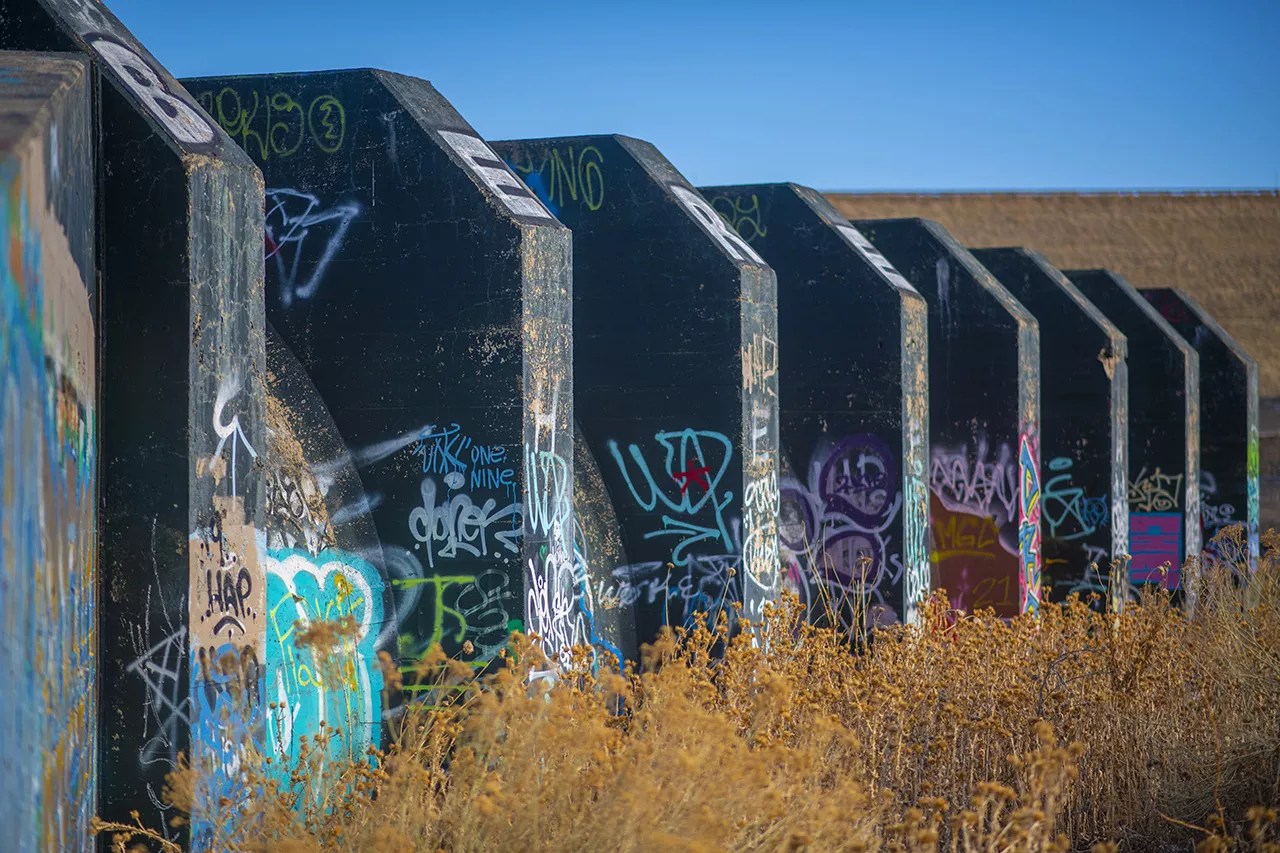
Graffiti marks the old spillway.
Evan Semón
The Kenwood Dam was built in the mid-1930s, after the failure of the Castlewood Dam across Cherry Creek in 1933, which resulted in two deaths.
Part of the Kenwood Dam was used in the construction of the Cherry Creek Dam, which was completed in 1950. The Kenwood Dam spillway was abandoned but remained intact. In the 1970s, some skaters, including Linquist, tried to skate it. Graffiti artists tagged it. And someone dumped debris there, though the city isn’t sure who. But it hasn’t been used for much else.
In September 2021, Kaily Blackburn, a thirty-year-old former professional snowboarder who grew up in southeast Denver and attended Thomas Jefferson High School, linked up with Black after hearing that the councilwoman was interested in building a skate park in her district.
A month later, Blackburn went to the spillway with Black, another TJ grad.
“I was definitely blown away,” Blackburn says. “I’ve been to a lot of skate parks worldwide; I like to travel for skateboarding. Just seeing the backdrop of all the graffiti and art that was there, it definitely got me excited. I haven’t been to very many skate parks that have been so iconic-looking.”
“It’s actually a massive bit of area in comparison to what normal skate parks are,” notes Seymour, who’s become a proponent of the site. “Normal skate parks can range to a quarter size of that footprint in terms of square footage and can still be a very decent park.”
Also now involved in the efforts is Mateo Rocha Mendoza, a 28-year-old English-language acquisition and arts teacher at Thomas Jefferson. “This is such a gem,” says Rocha Mendoza, who’s skated the spot in the past.
And the three middle-schoolers who pushed Black approve of the location. “Honestly, that place has potential,” says Price.
“We saw it for the first time and were like, ‘This is cool,'” adds Perry.
Black is finishing her second term on council and has opted not to run for reelection. “Eight years is a long time, and I feel like I’ve accomplished a lot and got a lot in the works, including this skate park,” she says.
“We have this interesting existing infrastructure that I would like to see reused, but a lot has to happen before we reuse it. We really need to get Parks and Rec to do some sort of planning process, and so hopefully we can get that in next year’s budget,” Black adds.
That means the big push right now will be to get the Denver Department of Parks and Recreation to earmark funding for a planning process when the 2023 budget is finalized in the fall.

A fence blocks off the spillway, but people manage to get through.
Evan Semón
Black has toured the site with various high-ranking Parks and Rec officials, including Deputy Executive Director Scott Gilmore. “We are definitely open to the possibility, but I don’t want people to get the expectation that this is going to happen overnight or anything,” says Gilmore.
“If you’re going to do a skate park and do it right,” he adds, the project could cost $10 million at a minimum. “I would think if we would want to do something there, we would want to do it on the scale of the downtown skate park.”
Gilmore estimates that the park would take a decade to complete, since the department budgets five years out from now. Foundation money could help move the project forward more quickly.
And the site has another advantage. “Here’s the one thing I think makes it really attractive: Denver Parks and Rec doesn’t have to buy any land to put that skate park in. In this instance, they don’t have to buy any land; it’s already there. That’s got to be a tremendous savings,” says Frank Rowe, executive director of the Denver Park Trust, a nonprofit organization that works to add and improve parks in underserved parts of Denver. Black co-founded the organization with Rowe.
The Denver Department of Public Health and Environment has inspected the surface concrete at the site and found no asbestos, which is another money saver. And noise disturbing neighbors won’t be an issue.
“It’s such a good environment. It’s right next to the highway, so it’s not going to make any more noise than the highway would,” Arterburn says.
There are other challenges, though, such as guaranteeing that the local light-rail stop is accessible and protecting skaters from errant golf balls. Since the golf course closes when the sun goes down, the city would also have to figure out a safety plan for the skate park at night. “My concern would be what happens after dark there,” says Pearson, “because there are really no eyes on the site.”
But recently, a bigger concern emerged. And getting this project through may be no walk in the park.

Dave Riordon wants the city to allow a DIY skate park.
Evan Semón
“There are two avenues on this. The way that Kendra Black foresees this is going through the normal traditional skateboard park build, which would probably take about five years,” says David Riordon, a 58-year-old Denver skater and river-surfing advocate. “Scott Gilmore thinks it’s going to cost about $10 million to $14 million to be done. That’s a pile of crap. That Kenwood Dam has been skated since the ’80s. The nickname of that place is ‘the wave.’
“There’s an effort to do a permission DIY,” he continues. “You get permission from the city with different avenues such as a nonprofit, you allow the skaters to get some sort of agreement from the city to use it as a legitimate skateboard park as it is, and the skaters can go ahead and start to put features in there such as bowled out-corners, little ramps, quarter-pipes.”
While cities have gotten into building skate parks that they oversee, some have authorized DIY skate parks, do-it-yourself models where skaters have more control, but the municipality still plays a role. Burnside Skatepark in Portland, Oregon, is one of the most well-known DIY skate parks. Skaters built the park decades ago without city permission. Today the City of Portland authorizes skating at the world-famous facility.
There are various sub-categories within skateboarding, such as vertical skateboarding or vert skateboarding, which often involves riding and performing tricks on a halfpipe or bowl, and street skateboarding, which features a rider making use of an urban environment. Skate parks often combine these categories to cater to all different types of skaters.
Still, Riordon is worried that a city-built skate park could “suck ass.”
“My skateboard ideas are completely different from Kendra Black’s, and she just doesn’t want to hear it,” he says. “She never took time to talk to me, even personally. I’ve got this passion and stupidity that no one wants to deal with, and I’ve just got sideways with them.”
“My skateboard ideas are completely different from Kendra Black’s, and she just doesn’t want to hear it.”
Black says that Parks and Rec officials are the ones who’ve rejected Riordon’s push for a DIY skate park. “The city is not open to the idea of a DIY skate park there because it’s not safe, and if they were to get permission for something like that, it would open the city up to a lot of liability. That’s why it’s fenced off,” she explains. “The city can’t sanction something that’s unsafe.”
Adds Gilmore, “The liability would be on us. That’s not going to happen.”
Until recently, Riordon had been working with Blackburn for more do-it-yourself influence at the spillway skate park. But then they had a falling-out.
“We were devising a plan, and then David went over my head, even though he was supposed to be on our team,” Blackburn says. “If I’m being honest, it’d be something that I’d really love. I understand the want for it and the need for it. I think there’s a chance to advocate for it, and maybe not at this location if that makes sense. You’re in a neighborhood where there’s never been a skate park before.”
Rocha Mendoza, who’s working with Blackburn to lobby for the spillway as a permanent site, says he can identify with Riordon’s desire to turn it into a DIY location. “This is a spot where, I hope, after a city-sponsored event, graffiti writers and BMXers alike can go to the spot and not be punished for writing on the walls or moving stuff around now that it’s city property,” he says. “There’s an autonomy. It’s kind of by us, for us.”
And while Linquist, one of Denver’s OG skaters, agrees that DIY spots can be fun, he believes the best DIY parks are under bridges, where they can be ridden year-round, like Burnside Skatepark, or completely unsanctioned, as Burnside once was. But he’s also a fan of public facilities. “I’m all for professionally built permanent skate parks, personally,” he says.
While Black says the city won’t accept a DIY skate park at the Kenwood Dam spillway, she does believe a city skate park there can have DIY elements.
“I would love it if we could reuse that infrastructure and keep the wall space for graffiti and just keep the whole vibe of the place,” she says. “That would be my wish. But we’ve got to do a feasibility study first to see if it’s possible to reuse.” And to gauge public interest, she and Blackburn plan to hold a pop-up skateboard event in the parking lot at the Kennedy Soccer Complex, which is right near the spillway, on June 5, which will offer skateboarding demonstrations, lessons, music and art displays.
Sturno, Price and Perry, who have been advocating for the skate park at Parks and Rec committee meetings, plan to attend. In the meantime, they’re going to keep skating in their driveways and on the streets of Denver.
Arterburn will be skating nearby. He still supports the skate park project, even though he knows it might not wrap up before he’s done with high school. “There’s just so many neighborhood kids who could be a part of that in the future,” he says. “Even though I most likely won’t, I just want to be a part of it for the future kids in the neighborhood.”